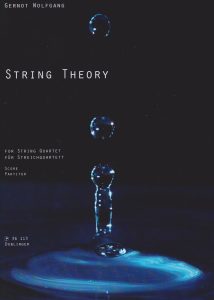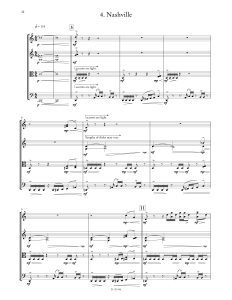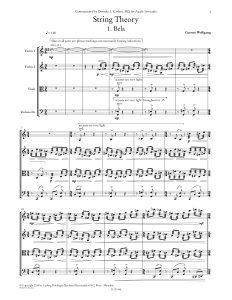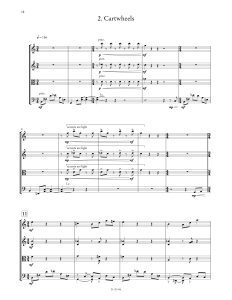STRING THEORY (2013)
for string quartet
Doblinger Music Publishers, Vienna (Score: catalog # 36 113; Parts: catalog # 36 113-71)
May 4, 2013 at a private home in Pacific Palisades, CA. Roger Wilkie and Connie Kupka - violins, Roland Kato - viola and David Speltz - violoncello.
Pacific Serenades
Gernot Wolfgang, PASSING THROUGH, Albany Records CD TROY 1624
_____________________________________________________
DOWNLOAD PROGRAM NOTES (English)
DOWNLOAD PROGRAM NOTES (German)



(click on images of excerpts to enlarge)
Stream on Spotify (album link, tracks 2-5)
Stream on YouTube:
1. Bela
2. Cartwheels
3. Northern Lights
4. Nashville
Watch a video of a live performance of movements 1, 3 & 4 by the New Hollywood String Quartet
More information about the recording of String Theory
on the GRAMMY®nominated album PASSING THROUGH
_____________________________________________________
Purchase the sheet music for String Theory at:
Theodore Front Musical Literature, Inc. (SCORE)
Theodore Front Musical Literature, Inc. (PARTS)
sheetmusicplus.com (SCORE)
sheetmusicplus.com (PARTS)
Reviews:
“Mr. Wolfgang’s string quartet, “String Theory”, is an absolute masterpiece. It was commissioned in 2013 for the Los Angeles chamber music series and is simply one of the best pieces of contemporary chamber music I’ve heard since discovering the music of Guillaume Connesson several years ago .. Not for an instant does Mr. Wolfgang’s inventive genius wane. The creative inspiration is everywhere present – and adorned in the most alluring orchestration. Color, textures and mood-changes are as varied as it gets, making this one of the most interesting new works to listen to.”
David Rowe, Classical CD Reviews
“There is a depth to this work that is really quite engaging, and convinces me that Wolfgang is a master composer with important things to communicate to his listeners.”
David DeBoor Canfield, Fanfare
“My favourite piece on the album is “String Theory” for string quartet, an appealingly diverse suite, with folkloric roots, landscape painting and allusions to Bartok and country music.”
Dean Frey, Music for Several Instruments
“At around 16 minutes, this energetic yet frequently lyrical work is an important and accessible addition to the vast string quartet repertoire. The first movement is an affectionate homage to the quartets of Béla Bartók. As with those remarkable works, this is skittish, dark, and propulsive music with the hint of exotic folk dance, quarter tones, and melismatic melodies. The lively second movement, “Cartwheels,” a pizzicato scherzo evoking cartwheeling people, contrasts with the third movement’s coldly brilliant meditation on the “Northern Lights.” A brief coda-like finale “Nashville,” named for the composer’s enthusiasm for the TV program, brings “String Theory” to a close.”
Don Clark, icareifyoulisten.com
“The performance by the New Hollywood String Quartet is superb, particularly the rhythmically complex pizzicato second movement; yet the expressivity of the slow third is just as affecting (the bare textures imply Scandic spaces, both awesome—in the true meaning of the word—and beautiful at the same time). The performance in the latter movement is particularly fine, truly expressive, with every nuance caught perfectly by the recording. By far the longest movement of the four, “Northern Lights” is a still center, providing a glowing interior for the piece as a whole.”
Colin Clarke, Fanfare
“I’d point out the string quartet, “String Theory”, as a beautiful example of the form, where the motifs of the four movements are overlapped, and variety is added by simple but effective methods such as going from arco to pizzicato. Wolfgang keeps the constant motion that’s prominent in his writing from turning jittery by inserting slow, lyrical interludes, such as the slow movement of the quartet, “Northern Lights,” which evokes the timeless silence of the sub-Arctic at night.”
Huntley Dent, Fanfare
“[Gernot Wolfgang’s] choice of programmatic titles in place of conventional designations enhances the music’s evocative potential. In “String Theory”, for instance, the New Hollywood String Quartet’s pizzicato playing in “Cartwheels” certainly does convey some of the gymnastic quality of body movement, whereas the contemplative character of “Northern Lights” captures something of the awe-inspiring impact of the phenomenon.”
textura.org
“The first movement, “Bela” (for Bela Bartok), starts all energy and rhythm with an interesting feel for texture. The music reminded me of mid 20th century works for string orchestra, not surprising in a work named for Bela Bartok. There are lyrical moments too, and an interesting sense of development. “Cartwheels” is a vibrant pizzicato movement, full of energy. “Northern Lights” is lyrical in a rather expressionist way, with intense moments. The final movement, “Nashville”, is again vibrant, rhythmically very appealing and full of excitement.”
Robert Hugill, planethugill.com
“The first movement, “Bela”, invokes the style of Bartok with interesting rhythmic pulses and shifts from bowed to pizzicato sections. The rhythmic ideas help provide a sense of urgency with some moments for lyrical solos among the ensemble. In “Cartwheels”, pizzicato becomes the primary vehicle for exploring the rhythmic ideas and the music has a slightly more jazz feel in the opening cello line. The lines that were once pizzicato are now strung out more in a slower bowed movement, “Northern Lights”. The thematic development here tends to grow out of a three-note cell that then becomes the basis for a Bartok-like dialogue within the quartet. Finally, “Nashville” (inspired more from the TV series then Tennessee). The first and third movements have the real meat of the work with the others being more succinct.”
Steven A. Kennedy, Cinemusical
“String Theory, for string quartet, demonstrates Wolfgang’s range, with a work firmly in a contemporary tonal language, with little overt reference to the composer’s jazzy side. I immediately felt the influence of Bartók as the music begins, with its bright tonal texture and energetic rhythmic sensibility, so I was not surprised to see, after the first audition, that Wolfgang had subtitled the movement “Belá, as an homage to Belá Bartók.” The other movements are also commentaries on specific influences, including the Northern Lights and Nashville. ”
Peter Burwasser, Fanfare

